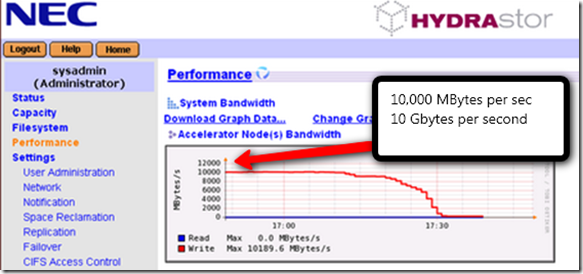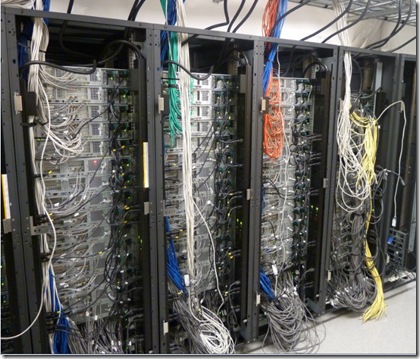Following my return from my first Tech Field Day I have been reading through my notes and reflecting on the vendors I saw when I was in Seattle. Of the vendors I saw the one that surprised me most was NEC, everyone has heard of them but not everyone actually knows what they do or what products they make. As we found out during our visit, NEC have a broad technology portfolio and have quite an interesting offering in the storage space.
Here are some basic facts about NEC that you may / may not know
- Founded in 1899
- Fortune 200 company with over 143,000 staff
- Revenues of $43 Billion in 2009
- $3 Billion spent in R&D each year across 12 R&D global labs
- 48,000 patents worldwide.
- Have been in storage since 1950
So with that little history lesson over, the main focus of our visit was NEC’s HYDRAstor. This is their modular grid storage offering for customers with backup and archive storage in mind. It’s marketed as “Grid storage for the next 100 years” which may sounds a little far fetched, but data growth and data retention periods are ever increasing. From what I saw and heard the HYDRAstor could very well live up to this bold claim.
There was a lot of content delivered on the day and the session went on for 4 hours, so I’ve tried to wrap up some of the key features below. I have expanded on the key elements of the HYDRAstor that really caught my attention as I think they are worth exploring in more detail.
Key Features
- 2 tier architecture based entirely on best of breed Intel Xeon 5500 based servers
- 2 tier architecture consists of front end accelerator nodes and back end storage nodes
- Shipped as a turnkey solution, though entry level can be bought for self racking.
- Supports a Maximum of 165 Nodes, 55 accelerator nodes and 110 storage nodes
- All interconnects based on 1GB Ethernet Networking (NEC Network switches included)
- Supports old and new node modules in the same Grid for easy node upgrade and retirement.
- Supports volume presentation with NFS and CIFS (SMB Version 1)
- Non-disruptive auto reallocation of data across any additional grid capacity – DynamicStor
- higher levels of resilience than RAID with a reduced capacity overhead (See DRD below)
- WAN optimised grid to grid replication minimises network bandwidth requirements — RepliGrid
- WORM Support for secure retention / compliance governance – HYDRAlock
- Efficient drive rebuilds, only rebuild the actual data not the whole drive.
- Global inline de-duplication across the entire grid — DataReduxâ„¢
- Tight backup vendor integration — strips out backup metadata to improve de-dupe ratios
- Mini HYDRAstor appliance available for remote offices or offsite DR replication.
Data Protection – Distributed Resilient Dataâ„¢ (DRD)
The resilience provided by HYDRAstor really caught my eye, primarily because it was so different from anything I had ever seen before. Distributed Resilient Data (DRD) uses something known as erasure coding to provide extremely high levels of resilience. Now you may think that this would come with a considerable storage and performance overhead, but you’d be wrong.
The HYDRAstor provides 6 levels of protection (1 — 6) all with differing levels of protection and capacity overhead. With the default level 3 selected NEC’s implementation of erasure coding splits the data chunks into 12 parts, 9 data and 3 parity. The use of erasure coding means that it only ever needs 9 parts to make up a complete data chunk. So if that data chunk is spread over 12 disks in a single storage node, it can withstand 3 disk failures. if those 12 chunks are spread over 12 storage nodes then you can withstand 3 complete node failures.
This default level 3 protection requires a 25% capacity overhead, much like RAID 5. However by providing for 3 disk failures it provides 300% more protection than RAID5 and 150% more protection than RAID 6. If you want to go to the highest level of protection (level 6) then there is a 50% capacity overhead as with RAID 1, however you can withstand the failure of 6 disks or 6 nodes.
The following video describes Distributed Resilient Dataâ„¢ (DRD) at the default level 3
High Performing
The demonstration NEC gave us was based on their lab setup of 20 accelerator nodes and 40 storage nodes. This was a 4 rack setup, which as you can see from the photo below is not a small setup. What it is though, is a very high performing storage solution.
NEC demonstrated a data copy that utilised a full 10GB per second throughput, which worked out at about 540MB throughput per front end accelerator node. The screenshot from the management GUI below shows the total throughput achieved.
The maximum HYDRAstor configuration consists of 11 racks and is capable of 25GB per second or 90TB per hour. This works out at roughly 2 PB’s in a 24 hour period, that is an astounding amount of data throughput. Surely a level of throughput to deal with even the most demanding backup or archiving use case.

There were a few negative aspects that I picked up on during our visit, thankfully all ones I feel can be addressed by NEC over time.
User Interface
I felt the user interface was a little dated (see screenshot above), it served it’s basic purpose but wasn’t going to win any awards. It was a stark contrast when compared with the very nice and easy to use GUIs we saw from Nimble storage and Compellent. That said if the HYDRAstor is only being used as a backup and archive storage and not primary storage, does it actually need to have the worlds best GUI, possibly not.
Solution Size
The HYDRAstor came across as a large solution, though I’m not sure why. When I think about it any storage solution that provides 10GB/sec throughput and 480TB of raw storage is likely to take up 4 racks, in some instances probably a lot more. Maybe it was the sheer number of network interconnects, perhaps some consolidation with 10GB Ethernet could assist in making the solution appear smaller. NEC could also look at shrinking down the servers sizes, probably only possible with the accelerator node servers as the storage nodes need 12 x 1TB disk so not a lot of scope for size reduction there.
Marketing
A general consensus among delegates was why have NEC marketing not been pushing this harder, why had so many of us in the room not heard about it? I suppose that was one of the reasons we were there, to hear about it, discuss it and ultimately blog about it as I’m doing now. There are some specific target markets that NEC maybe need to look at for this product, possibly looking at world wide data retention regulations as a means of identifying potential markets and clients. More noise needs to be made by NEC about there efficient de-dupe integration with enterprise backup products such as CommVault Simpana, Symantec NetBackup, TSM and EMC Networker. More comments such as the one below wouldn’t hurt.
with the application aware de-duplication for CommVault we’ve optimized storage efficiency with a four times improvement in space reduction.
Pete Chiccino, Chief Information Officer, Bancorp Bank
EMEA availability
NEC told us that this product is not being actively pushed in the EMEA region. Currently the product is only available for purchase in North America and Japan. One of the points I made to NEC was that the HYDRAstor appeared to me to be a product that would have a lot of applications in the European market place, possibly more so in the UK. I made specific reference to FSA regulation changes where Financial companies are now required to keep all electronic communications for up to 7 years. NEC’s HYDRAstor with it’s high tolerance for failure, global de-duplication across all nodes and grid like extensibility is perfect for storing this kind key critical complaince data. That is a very specific example, another is insurance companies who have longer retention requirements and museums digitising historical documents / books which have a “keep forever” retention requirement.
NEC contacted me via twitter after the event to say that although not on sale in EMEA if a company has a presence in the US they will be able to explore purchasing the HYDRAstor through NEC America.
Summary
I had no idea what to expect when we arrived at NEC’s offices, sure I knew who they were but I had no idea what they were doing in the storage space. Gideon Senderov at NEC certainly saw to it that we had all the information needed to form an opinion, his knowledge of his product was simply outstanding.
NEC HYDRAstor is a product that is quite unique. It’s easy to scale up and scale out, has high levels of redundancy without the normal capacity penalty and of course exceptional levels of performance. It strikes me as a product that any IT professionals responsible for backup, archiving and long term data retention would be very, very interested in
Note : Tech Field Day is a sponsored event. I receive no direct compensation and take personal leave to attend, however all event expenses are paid by the sponsors via Gestalt IT Media LLC. The views and content expressed here are my own and is in no way influenced by the sponsors of this event.





